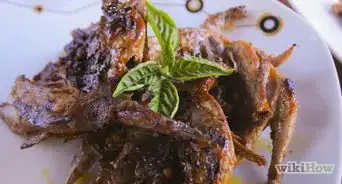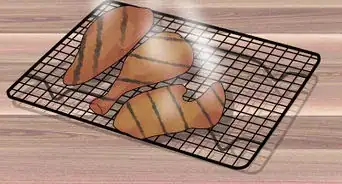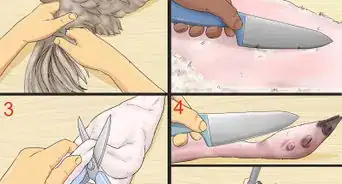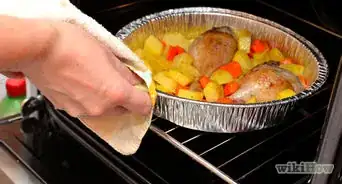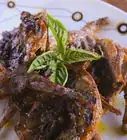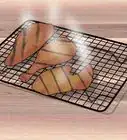This article was co-authored by wikiHow staff writer, Hunter Rising. Hunter Rising is a wikiHow Staff Writer based in Los Angeles. He has more than three years of experience writing for and working with wikiHow. Hunter holds a BFA in Entertainment Design from the University of Wisconsin - Stout and a Minor in English Writing.
The wikiHow Video Team also followed the article's instructions and verified that they work.
This article has been viewed 35,177 times.
Learn more...
Duck legs are larger and have a richer flavor than chicken.[1] The duck fat makes the meat more tender so it falls right off the bone when it's finished cooking, and it doesn't require many spices to taste great. Whether you braise the legs so the skin is crispy or if you roast them in the oven, you can have a delicious, flavorful meal with this easy recipe!
Ingredients
- 2 duck legs
- 2 large onions
- 1 pound (450 g) of carrots
- 6 celery stalks
- 2 cups (470 ml) of chicken stock
- 4 duck legs
- 2 tablespoons (30 ml) of olive oil
- Salt and pepper to taste
Steps
Braising the Duck Legs
-
1Preheat the oven to 400 °F (204 °C). Make sure one of the racks inside the oven is in the center position before preheating your oven. Don’t cook anything in the oven until it’s completely heated or else your food will not cook evenly.[2]
-
2Remove the skin from one side of the duck legs. Use a thin chef’s knife to slice into the skin on each duck leg. Slide the knife underneath the skin to separate it from the meat. Only remove the skin from one side so you can enjoy the crispy skin once it’s cooked.[3]Advertisement
-
3Crisp the skin on the duck legs in a skillet over medium heat for 15 minutes. Lay the duck legs so the skin side is down. Leave the legs in the pan until the skin gets brown and crispy, which should take around 15 minutes at medium heat.[4]
- You don’t need to add any additional cooking oils since the legs will cook in the duck fat.
- Use a large skillet that can hold all of the ingredients and is safe to use in the oven.
-
4Peel and dice the onion, carrots, and celery while the duck legs cook. Remove the outer skin from the onion with your hands and use a vegetable peeler to remove the skin from your carrots. Use a chef’s knife and a cutting board to dice the veggies so they are 1⁄2 by 1⁄2 inch (1.3 by 1.3 cm) cubes. This ensures that they cook evenly.[5]
- Use any root vegetables you want, such as parsnips or scallions, for different flavors.
-
5Sear the skinless side of the duck leg for 2 minutes and move them to a plate. Flip the duck legs using a spatula and let the exposed meat sear. This will help further lock the juices in the meat. After they’re finished, transfer them to plate skin-side up and let them rest.[6]
-
6Brown the vegetables in the duck fat for 10 to 15 minutes. Place all of the vegetables into the skillet along with the duck fat. Stir them occasionally with a wooden spoon so all of the veggies cook through and soften evenly.[7]
- You can drain up to two-thirds of the duck fat if you want, but it’s not necessary.
-
7Put the duck back in the pan and add the chicken stock. Set the duck on top of the vegetables so the crispy skin is facing up. Pour in 2 cups (470 ml) of chicken stock into the skillet so half of the duck is submerged. Don’t get the skin wet or else it will turn soggy and rubbery.[8]
- You can purchase chicken stock at your grocery store or make your own!
-
8Bring the skillet to a boil over high heat. Turn up the heat and let the stock boil for 1 minute. Once it’s been boiling, turn your stove off completely.[9]
-
9Place the skillet in the oven for 30 minutes. Use an oven mitt to hold the skillet handle and set the skillet on the center rack of the oven. Set a timer for 30 minutes and avoid opening the door so heat doesn’t escape.[10]
-
10Reduce the heat to 350 °F (177 °C) and cook for another 30 minutes. Once your timer goes off, lower the heat and set another 30-minute timer. When the duck is finished, it should easily be pierced with a knife. Serve the duck legs and vegetables while they’re still hot.[11]
- The duck will stay warm in the oven for 1 hour after it’s finished cooking.
- Use a meat thermometer to make sure the duck is 165 °F (74 °C) in the thickest part of the leg.
-
11Refrigerate the duck for 3-4 days. Place the duck in an airtight container or a resealable plastic bag. Make sure to put the leftovers in the fridge within 2 hours after cooking it. Otherwise, harmful bacteria could form on the meat.[12]
- Duck can be kept in the freezer for up to 3 months.
Roasting Duck Legs
-
1Preheat the oven to 350 °F (177 °C). Set one of the racks to the center position in your oven before you turn it on. Make sure the oven is fully heated before cooking in it.[13]
-
2Poke holes in the duck legs with a wooden skewer. Stab into the skin side of the meat with a skewer, making sure you don’t go all the way through it. Aim to have 15-20 holes on the duck leg. The holes allow for the duck fat to release while it is cooking.[14]
- Use a fork to poke multiple holes at the same time.
-
3Brush the legs with olive oil and season it with salt and pepper. Spread 2 tablespoons (30 ml) of olive oil across the entire surface of the meat with a kitchen brush. Sprinkle on salt and pepper until you have the level of seasoning you desire, but be careful of over salting the meat.[15]
- Use other spices like thyme or red pepper flake to add more aromatic flavors to your duck.
-
4Place the duck legs on a baking sheet with a wire rack. Spray the cooking sheet and wire rack with cooking oil so your duck doesn’t stick. Put the baking tray with the duck legs on the center rack of the oven.[16]
-
5Cook the legs for 90 minutes. Keep the door closed while the duck is cooking so you don’t let any of the heat out. After 75 minutes, check the internal temperature of the duck legs with a meat thermometer. If it isn’t at 165 °F (74 °C), let it cook for the last 15 minutes.[17]
- Sanitize your meat thermometer with dish soap before using it again if the duck wasn’t cooked to temperature.
-
6Cover the duck with foil and allow it to rest for 10 minutes after cooking. Remove the duck legs from the oven and immediately wrap the tray in aluminum foil to keep the duck warm. Let the legs rest for 10 minutes before serving them.[18]
- Roast duck pairs well with wild rice.
-
7Store the duck in the fridge for up to 4 days. Keep the duck legs in an airtight plastic container or a plastic storage bag. Put your leftovers in the fridge within 2 hours so harmful bacteria doesn’t form.[19]
- Keep duck in the freezer for up to 3 months.
Warnings
- Cook all duck meat thoroughly to an internal temperature of 165 °F (74 °C). Measure the temperature in the thickest part of the meat to make sure it’s cooked through.[20]⧼thumbs_response⧽
Things You’ll Need
Braising the Duck Legs
- Oven-safe skillet
- Range
- Vegetable peeler
- Chef’s knife
- Cutting board
- Spatula
- Plate
- Wooden spoon
- Measuring cup
- Oven mitt
- Meat thermometer
Roasting Duck Legs
- Baking sheet with wire rack
- Wooden skewer or fork
- Cooking brush
- Oven
- Oven mitt
- Meat thermometer
References
- ↑ https://savorthebest.com/roasted-duck-legs-orange-sauce-wild-rice/
- ↑ https://www.nytimes.com/video/dining/100000001154419/braised-duck-.html
- ↑ https://www.nytimes.com/video/dining/100000001154419/braised-duck-.html
- ↑ https://www.nytimes.com/video/dining/100000001154419/braised-duck-.html
- ↑ https://www.nytimes.com/video/dining/100000001154419/braised-duck-.html
- ↑ https://www.nytimes.com/video/dining/100000001154419/braised-duck-.html
- ↑ https://www.nytimes.com/video/dining/100000001154419/braised-duck-.html
- ↑ https://www.nytimes.com/video/dining/100000001154419/braised-duck-.html
- ↑ https://www.nytimes.com/video/dining/100000001154419/braised-duck-.html
- ↑ https://www.nytimes.com/video/dining/100000001154419/braised-duck-.html
- ↑ https://www.nytimes.com/video/dining/100000001154419/braised-duck-.html
- ↑ http://www.stilltasty.com/fooditems/index/17120
- ↑ https://savorthebest.com/roasted-duck-legs-orange-sauce-wild-rice/
- ↑ https://savorthebest.com/roasted-duck-legs-orange-sauce-wild-rice/
- ↑ https://savorthebest.com/roasted-duck-legs-orange-sauce-wild-rice/
- ↑ https://savorthebest.com/roasted-duck-legs-orange-sauce-wild-rice/
- ↑ https://savorthebest.com/roasted-duck-legs-orange-sauce-wild-rice/
- ↑ https://savorthebest.com/roasted-duck-legs-orange-sauce-wild-rice/
- ↑ http://www.stilltasty.com/fooditems/index/17120
- ↑ https://www.fsis.usda.gov/wps/portal/fsis/topics/food-safety-education/get-answers/food-safety-fact-sheets/poultry-preparation/duck-and-goosefrom-farm-to-table/ct_index
About This Article
To cook duck leg, start by removing the skin from one side of the leg, then laying the leg skin-side down in a skillet over medium heat. Cook for 15 minutes, or until the skin is brown and crispy. While the duck leg is braising, peel and dice onions, carrots, and celery. Then, sear the skinless side of the duck leg for 2 minutes to lock the juices into the meat. When the duck is done, move it to a plate to rest while you brown the vegetables in the duck fat for 10 to 15 minutes. Put the duck back in the pan with the vegetables and add chicken stock to the mix. Bring the skillet to a boil over high heat, then move it to an oven set at 400 degrees Fahrenheit for 30 minutes. Finally, reduce the heat to 350 degrees Fahrenheit and cook it for another 30 minutes. To learn how to roast duck leg, keep reading!
